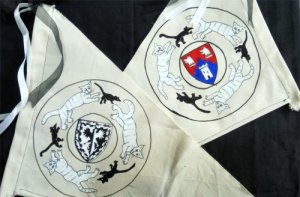 |
|
Crown - A Rat and a Cat ConsortBond of Manrent and Letters of Intent for Crown TournamentRat Heraldry: Banner, Mini-Flags, Pennons
[Consorting Garb]
[Rat Stuff]
[Consort Correspondence] In ASLIV, Sir Radbot von Borg and I agreed to consort with each other so as to enter that year's May Crown Tournament, being held in Darton. Thus began a whole new phase of magnificant obssessions.... Bond of Manrent and Letters of Intent for Crown TournamentI've been intrigued by the Scottish contract form of the bonds of manrent, having read over a large variety contained within the Black Book of Taymouth (Innes, 1855). So they seemed a good model for the agreement between Sir Radbot and me. I duly scribed a version based on the WirWenzlaw font by Pia Frauss (very close to a 16th-century Scottish hand), and gussied it up with a painting of our respective arms and a large Cadell capital B, ready for signing.
The Bond wording was quoted in our Letter of Intent, the communication typically required by the Crown from those planning on entering a Crown Tournament. Ours was presented in a suitable font (as it was sent electronically) and worded thusly: Unto Their Most Puissant Majesties of Lochac, Felix and Eva, do Sir Radbot von Borg and Mistress Katherine Kerr send loyal greetings. As noted in the bond and letter, we took the contract to the Darton May Crown Tournament for our signatures and seals. While a period bond of this type would typically have 3-10 witnesses of note, I wanted anyone to feel they could participate in this, so all present were invited to act as witness; forty-one did so. Their Majesties signed the chirograph, writing In recognition of a firm bond Eva Felix. That area was cut in two for our separate copies.
First AmendmentAt the July baronial monthly tournament following May Crown, we presented our bond to the Baron and Baroness, attesting that we had each lived up to our terms, albeit the ultimate prize had been missed by a rat's whisker (Sir Radbot was runner-up, the Champion of Lochac). It was noted that the wording of the contract was ambiguous, in that it failed to state which Crown Tourney was covered by the terms. And so there was some discussion as to whether we would continue to consort, resulting in an amendment, duly signed and sealed at July Coronation and attached to the original bond, which said: Let it be knowne that Sir Radbot von Borg & Baroness Katherine Kerr hav agreeit to maintayn & continew with the hereunto attached Bond of Manrent in tha same termes & conditions as subscribed as publickly witnessed on the nones of July ASliv and to consort together unto the completion of Maie Crown Tournament ASlv.
I had surmised that period contracts would have extensions and assumed these would be cut and sealed onto the originals or sewn together. So I was pleased to find actual examples of contractual amendments being sewn to the original documents or tucked into the page turn-up and sealed in place. One which demonstrates parchment and paper amendments sewn to an original indentured deed covers a conveyance concerning the sale of land in Stratford in 1611, involving a member of Shakespeare's family. And there’s a brilliant water bond issued by a Dutch water board in 1648 to fund their waterworks. The bond is in perpetuity so is smothered in payment updates. Yale's Beinecke Library ran into the difficulty that they couldn't release it from their collection but payment was due -- fortunately, once space ran out on the original parchment in the 1940s, someone attached a piece of paper as an addendum. In 2015, a library curator was allowed to detach the paper slip and go to the Netherlands to present it and bring back the 136EUR in interest owing! Non Consummatum and Second AmendmentThe best of intentions notwithstanding, our first amendment failed to bear fruit, due to the postponement and then the cancellation of May Crown LV (because COVID). I penned a brief notice to that effect on the talon: FINIS EST SED NON CONSVMMATUM
Our B&B duly signed it as witnesses, I added a paper-embossed seal of the Southron Gaard tower. I cut through one part of the amendment with chevron-slashes and struck out another section with pen strokes, both measures used in period to note a void document.
Ratbot and I then agreed to remain hopeful of contesting Crown, but that it might take some time, so we added yet another talon, this time tucked into the page turn-up and signed with our initials. My seal tag is made of real parchment, with the tag looped through a vertical slit as per period practice. I was trying to get the same effect as on a number of period documents I have, but couldn't get the wax to build up into the exemplars' distinctive pebble shape. More research.... Here is the wording for our second amendment: Know all people to whom these presents shall come we Sir Ratbot von Borg and Baroness Katherine Kerr in this Indenture hereunto signed sealed and named are to continue with this Bond and all its Terms and Conditions as heretofore agreed And seeing that the Life of Man is short and Death sure and the houre of Death unsure as is the time and place in which this Bond may be consummated by reason of the Great Plague therefore this agreement is to hold good unto the end of anno societatis lv. So the extension was to takeus as far as April 30 AS55/2021 which could have been enough to take to the Crown Tourney field once more...or not. The addition of another i on that lv year meant a further extension of the Bond and more hopeful letters (see below). When Her Excellency Elyna of Ildhafn mentioned sadly that she hadn't been a signatory, I organised a little by-play at the Baronial Anniversary feast when the year was changing from AS56 to AS57. Appropriately enough, given that, it began like this, referencing the Baronial Champion Heavy Tournament on the morrow's May Day: KK: Sir Ratbot – do you fight tomorrow for me, sir? Sir Philippe read out the Bond in his best Scottish regimental accent, and there was a bit of inquisitorial commentary from Her Excellency. Sir Ratbot was attracted by the thought of improving the T&Cs and, after a bit of silliness regarding who had given what to whom, I finished by answering Elyna's charge of lack of consummation showing a lack of ambition by declaring: ...in our defence, the attached codicil notes that the lack of consummation in this regard comes not from a failure of prowess on Sir Ratbot’s part, nor from a failure to inspire him on mine, but by reason of the Great Plague. Fate has held us back but we look to challenge her in September when we travel to Innilgard to contest the Spring Tournament for the Crown of Lochac. The consummation, as always, remains in Fate’s hands. And Her Excellency then sealed her talon to the Bond with the lymphad seal of Ildhafn, extending the Bond for another year. Ratbot's Score-Card, or Jousting ChequeMy copy of our Bond of Manrent has an extra addition in the form of a jousting cheque-style record of Sir Radbot's wins and losses at the Crown events (regius ludi equester; tourney and coronation); as well as as list of his attendance and placings at our monthly baronial tournaments and local events. I've kept the entries in my bad Latin, noting the Feast Days and dates, cancellations or non-attendance and the occasional tourney prizes I have had as attending consort of a tourney winner -- Master Brian di Caffa makes beautiful tokens for this purpose; I have a set of "enamelled" badges (Lochac, the Southron Gaard tower and the Canterbury Cross) now attached to my consorting fealty chain. The script is a suitable secretary hand starting with sepia (squid-derived) ink, using a dip pen; now with whatever comes to hand. The score-card also notes the various honours that have accrued to Sir Ratbot -- his second placing at May Crown LIV saw him become Champion of Lochac, and he was also awarded a Rowan (for courtesy) as well as a Court Barony. The cheque also has a couple of tokens attached from the Rose Tourneys he has fought (typically I get the first rose, then he spreads the joy).
When Lady Gisle became Sir Radbot's squire, she produced a beautifully illustrated indenture containing their oaths (and with much rattage). It was good to see another contract in place, though I'm still trying to find out more about one reference I saw to "squire's bread" or panem ad armigerum, used to pay one's varlets. Second Letter of Intent: The Wager of LawI think we can all agree that 2020 was not a typical year. May Crown was cancelled due to COVID, then the July Crownanation backup, then November Crown...all the while Their Majesties Theuderic and Engelin sat upon a lonely throne. In November They called for Letters of Intent to enter Twelfth Night Crownanation in January 2021, to be held in the Continental lands. It seemed highly unlikely that Sir Ratbot and I would be able to make it without sitting through two weeks of expensive quarantine on our return, but we figured we could show our interest with a letter, even without our presence. This second letter is Germanic in inspiration, based on the Wager of Law concept where seven people of rank (Eideshelfer) would swear that the oath taken by an individual was pure. In this case, we had seven Barons and Baronesses witness it, though none swore on their swords or cattle as the Germans did.
Your Most Gracious Sovereign Maiesties who have blessed the Kingdom so long with Your presence Know that we have heard Your Call for Succour Peace and Release, even in these lands so distant from Your Court. The letter uses a number of terms from Germanic Common Law, technically some centuries earlier than Sir Ratbot’s period but even 12th-century legal practices tended to have long legs. Swearing "under the free sky" (freiem Himmel) was a thing, and seemed appropriate for a statement being witnessed at a camping event. Freudensprünge are "joy jumps", recently reported as common – and surprisingly sophisticated -- behaviour in rats playing games of hide-and-squeak with their human keepers (yes, really!). One early use of the Wager of Law (otherwise known as compurgation) dates from 899 when Queen Uta of Germany was acquitted of adultery thanks to 82 knights who swore to her chastity. In early criminal trials, compurgation did not speak to the facts of the case, but to the credibility of the oath-maker (aka accused) and their believed incapacity to commit the crime concerned. This approach clearly had some problems, which were ultimately addressed through the development of the juror system, but it was practised in England and its colonies through to the 16th century for criminal cases, and to the 19th century in civil courts. Appropriately enough in our case, a Wager of Law tended to be followed by Trial by Combat…. Sadly the Twelfth Night Tourney was postponed. And we still couldn't go; here's an excerpt from our cautious letter of marginal hope: We have, to date, done well to keep the plague under such control as we can, and merely await the widespread assistance of the chirugeons and their tame animacules to purify the sanguinous humours. I suspect that they are not likely to ply their skills to such as we in time to permit unfettered travel for the March Crown Tourney, but as always, we live in hope and will make such preparations as we can for that happy time. The Third Letter: The Holy Roman Empire Letter
Our third Letter of Intent was based on letters of notification issued by the Holy Roman Empire regarding the election of the King of the Romans (Thatcher & McNeal, Chapter XVIII). We sent it in to TRMs Rowland and Tailtiu for the Autumn Crown Tourney (March 2021) and crossed our fingers, but it was not to be, and yet another letter of withdrawal had to be sent. To Their illustrious and magnificent Majesties of Lochac, Rowland and Tailtiu, rulers and liege lords, by these presents know that we have heard of the approaching Crown Tournament to select Your Heirs and that we, Sir Ratbot von Borg and Baroness Katherine Kerr, in answer to the terms of the Bond of Manrent contracted between us, duly intend to come to that tournament at whatsoever time and place as may be confirmed, providing that there is no impediment to our travel requiring us to remain within our own lands, and if such should occur we will inform You of that fact by St Davids Day, if this date prove acceptable to You, and acknowledge that, should this barrier remain, the tournament will proceed to carry out the aforesaid business in spite of our absence, as with all other things required by the laws of the Kingdom in this matter. In verlorene haufe we affix our sign before true witnesses. The accompanying cover letter noted that we were standing ready to take to the High Seas when the time came but acknowledged that we were prepared to once again bear the brunt of the harsh reality of the plague-ridden World beyond our own lands. St David’s Day, being March 1st, was our go-no go date. We did have a bit of silliness, with Ratbot adding his concerns about my despair to our notice of withdrawal on St David's Day, intimating I had lost faith in him and had gone gallivanting off again. I riposted with a response while on the road, sending a verbatim predictive text: “To Their Majesties of Lochac” came out as “To Their Hairstyles of Outcasts”. In a subsequent note I apologised profusely for the barbarous nature of the letter's vocabulary, explaining the difficulty in finding a good scribe on the road. Letters 4-6: The Struggle to Free Odysseus SeriesThe next set of letters were initially inspired by reference to a series of letters written in the 1390s-1410 where ladies of the court wrote to the Queen as if from a mythological queen (eg eg Pantesilia, Judith, the Queen of Nubia) recommending a worthy combatant to enter the lists. They were described as vivid early contributions to the deliberate theatricalisation of battle games between members of the court (Carpenter et al), which sounded a perfect model for an SCA Letter of Intent. This inspired me to compose a series of Letters of Intent for Crown Tourney. The first two in the series drew heavily on Homer’s Iliad and Odyssey, discussing the fate of heroes and, in particular, referencing the story of Odysseus (aka Ulysses) who was held captive on an island for seven years by the sea nymph Calypso. In our case, Sir Ratbot von Borg was trapped on an island across the seas unable to test his fate at Crown Tournament, referencing our predicament during the height of COVID when travel between Australia (the Continent) and New Zealand (the Crescent Isles) was banned or extremely difficult for a number of years. Letter 1, the Calypso Series: A Prayer to ZeusThe first Letter of Intent in this series (Spring Crown & Coronation, November 2021) sent to TRMs Oze and Miriam, was in the form of a prayer to Zeus for Sir Ratbot’s release, and described as a “heartfelt plea intercepted from the aether as it floated up to Olympios on the smoke of a sacrifice”. It was based on Athena’s pleas to Zeus to release Odysseus from Calypso’s grasp and referenced widely from Homer (Odyssey, Bk I). O mighty Zeus, Father of us all, thou son of Cronos, high above all lords, if I ever before helped you among the immortals, in word or action, grant me this favour.
My heart is torn for the noble and steadfast ippotis Ratbot von Borg who, far from the circle of the Royal Court of Lochac, has long been suffering captivity in a sea-girt isle, where is the navel of the sea. Therein dwells this wretched man of constant sorrow, filled with longing to prove his skill at arms but trapped by circumstances that constrain him, sore against his will.
Ere now, the seasons have revolved again and again and still the gods have not ordained the courageous one's return to the foremost of tournaments. Ratbot bears in his breast a courteous and honest heart that endures affliction without complaint; he has suffered much and toiled much in striving to reach his King's high-roofed hall, to no avail.
Father of us all, far-echoing Zeus, if indeed it is now well pleasing to the blessed gods that the puissant Ratbot, man of prowess, should take voyage to far Innilgard, send forth your messenger swift Hermes to the isle where the yearning one lies, and with all speed allow the travels of Ratbot of the steadfast heart, that he may finally come home to the Royal list field once well-known of old. We received a truly charming reply from Their Majesties commiserating with our circumstances and wishing us well. And so on it went... Letter 2, the Calypso Series: Zeus Weighs the BalanceOur second Letter expounded on the uncertain future resting in the balance/scales where the hero’s fate is unknown (Dietrich; Morrison; Iliad 22 209-254). The Greek concept of the ker/keres is a kind of battlefield fate personified in the form of a female demon a bit like a really vicious Valkyrie (no relation to me!). The text referenced this along with the weighing of the scales of destiny; a not-alive-not-dead cat to mark life’s uncertainty; and the toss-up between a short glorious life or a long anonymous one (as was offered to Achilles). Father Zeus weighs the ker of Sir Ratbot von Borg on the golden scales, as he has done many a time to reveal a heros future. Until the scales stop swinging, Sir Ratbot, as with Achilles of old, has two fates: one will allow him to go on and seek the ultimate prize of a short but glorious reign, the other will see him yield the glory to others and instead live on in peace and obscurity in his homeland. Like the undead-but-not-alive cat, which way the scales will swing and whether the balance of the ker is bright or dark is unknown and unknowable as yet.
I scribed this letter on a papyrus scroll with a drawing of Zeus holding the scales. The Eagle of Zeus next to him was an omen of victory used on the god’s battle standard; it is also Sir Ratbot’s primary heraldic charge. An electronic version was sent to the Crown after yet-another confirmation that we couldn’t compete due to COVID travel restrictions. These letters enabled us to cite our desire to enter Crown while making it clear that we knew we were highly unlikely to be able to participate. In addition, they provided the groundwork for the major missive, the Calypso Letter, which I decided to save for the first tournament that we would actually be able to attend (though we hadn’t expected to have to wait three years between our first Crown Tournament together and our second!). The Calypso LetterThe third and final letter in the series reflects Calypso’s release of Odysseus, with the text closely modelled on the Jousting Letters from the Royal Letter Book (EUL MS 183) of Edward III's reign. According to Carpenter et al, the Jousting Letters used a motif common to courtly performance entertainment throughout the 14th to 16th centuries of “the arrival of supposedly unknown visitors from distant exotic lands, to honour, if also challenge, the court of the resident royal host” (pg 7). It introduces the combatant and his consort in the context of the fantasies of High Romance and “playful chivalric spectacle” (Carpenter, pg 3) as was orchestrated in period by the ladies of the court and carried out by heralds and combatants through extensive vocal and visual displays. I went somewhat over the top with the text, combining as much material from the Jousting Letters as I could, to produce a Letter of Intent about three times the length of the originals. This was partly a rush of blood to the head, partly a desire to match the aspect ratio of the physical exemplar noted below, and partly driven by a concern that I have diminishing opportunity to be able to produce a work of the quality level I desired to do justice to the source material. The Jousting Letters were designed to be seen and read aloud, which made it appropriate to have this on display at Crown Tourney and, ideally, declaimed by a personal herald as part of the proceedings. I note that Lochac’s Crown Tourneys do not usually honour this tradition, though we have had other Letters of Intent displayed and heralded at Baronial Championships. Having worked on these Letters for some time now, it was gratifying to read that the Jousting Letters are an example of “mixed gender entertainment in which women could partake, and perform, on seemingly equal terms” (Carpenter pg 12). Brava! A Theatrical, Chivalric TextThe Calypso Letter uses many of the phrases contained within the Jousting Letters in terms of salutations, flowery compliments and OTT descriptions of the puissant fighter being despatched to answer the challenge of combat (an Orca amongst Spratlings!). The main text difference is that our letter does not specify the actual terms of combat – in our case, that is of course up to Their Majesties to determine. Although clearly allegorical, the Calypso Letter, like its Jousting Letter counterparts, follows standard conventions of public correspondence with private allusions and familiar/contextual cultural references eg Shakespearean and Biblical quotes. I also confess to including anachronistic lyrics drawn from John Denver’s song Calypso (I’ve always had a soft-spot for this because of its association with the Jacques Cousteau ocean exploration television series I loved as a kid). The Lady of the Seven Seas, Nymph of Ogygia
and Protector of those who go out on the sea in ships
to the most Excellent and Noble Queen of the chivalrous people of the Sceptered Isles of Lochac being those precious stones set in the silver Sea of Peace namely the Crescent Isles, Ynys Fawr & Terra Rosa, do I sing to your spirit from the depths of Mother Tethys and the breadth of Father Oceanus, honour, pleasure, joy.
Most Excellent Lady of the Isles of the Ocean, I have heard from distant kingdoms and honourable courts an account of the very great fame and renown concerning the very many excellent and famous tourneyers who are to contest the honour of holding those lands and titles to be awarded by You and Your Very Noble and Powerful King.
I speak of the redoubtable knight Sir Ratbot von Borg whose chivalry to other noble tourneyers bears no other comparison than that of the great and shining Moon to the small and lesser stars, or of the skilful and cunning Orca to the tiny lowly spratling. He may be known by the shield he bears of argent and sable per pale, an eagle and on a bordure embattled an orle of rats courant, all counter-changed.
Thusly I beg most sincerely with a whole heart of Your gracious nobility to admit him to the lists in your presence so he may delight You with his Prowess, impress You with his Courage, please You with his Honesty, and charm You with his Courtesy, such are his avowed and manifest Virtues.
And because the source and fountain of love and arms is perpetually fixed in Your Court of fame and Renown, as birds are in the air and mariners in the salt sea, I therefore propose and seriously determine to send with our dear and well-loved knight his good lady-consort, the wise, dutiful and generous Baroness Katherine Kerr.
And so as to assure You, O Queen of Pleasurableness and Joy, of the seriousness of their sincere intent to attend upon Your tournament - notwithstanding the divers wild raging storms which have prevented them from sailing on their dream across my crystal clear ocean to present themselves on past occasions - I have commanded them to sign by hand manual and seal and display their sigils upon this missive that You may know them should Poseidon and Hermes grant them safe passage per mare et per terras unto the welcoming dry haven of Your famed and honourable Court and Royal Tournament.
I ask, if it pleases you, to send me word to certify by Your messengers what has been achieved - if Sir Ratbot executes with honour the challenges he is set without losing his life or his health, and if his lady-consort carries herself with grace and inspiration. For hearing such would bring me more joy even than word that they have won the final prize.
Given by my hand manual in the Castle of Ogygia in which Venus will take her ease to rest bathed by the calm waters of the Chatham Rise. Being the xiiith day of Metageitnion, sacred to Poseidon and Theseus in this the iii year of the dccth Olympiad, known in the upper world as the Feast Day of St Ninian, anno societatis lvii during the reign of King Alain and Queen Safiya of Lochac. The Challenge used two different coloured inks – sepia for the text and black for the signatures. I reversed this as my black ink pen is far more reliable than my sepia at the moment. I also decided Calypso’s signature should be blue for her watery domain. It is centred and larger than the other signatures – as is Henry VIII’s on the original – and uses a flourished hand based on the type labels on 16th-century sea charts produced by the likes of John Speed, Mercator, Ortelius et al. A 16th-Century Tournament ChallengeThe Royal Letter Book does not contain the original Jousting Letters but scribal copies recorded amongst its 374 entries. Given that, and the fact that this sort of themed “set-dressing” for royal tournaments was popular through to the 16th century, I decided not to produce a matching 14th-century patent, and instead used the 1511 Westminster Tournament Challenge (Harley 83 H 1) as the physical model. I have wanted to make something based on that for some time now, and it also brought it closer to our own early-mid 1500s period. Even better, I later discovered that the Challenge, like the century-older Jousting Letters, is framed as coming from a fictitious Queen. In the Westminster Challenge, Queen Lady Renome from the Realm of Ceure Noble announces she is sending four knights to Henry VIII’s court to tourney (SOA).
The Challenge is thought to have been produced by Thomas Wriothesley, Garter King of Arms, for the lavish Westminster Tournament held on 12-13 February 1511 (Walker, pg 4). This high-end affair had all the fantastical trappings of a romantic Burgundian tournament: pageant cars, lists trees, a moveable castle made of gold tissue, heraldic emblemata, narrative/fantasy-based challenges, a 60-foot vellum Roll record. Based on ink differences, it is thought that participants signed their names before each day’s jousts and the Challenge was then displayed upon the lists tree. It is the only such example to have survived, having been folded up and apparently stored in the College of Arms archives of legal works (Walker, pg 3). The Challenge lists the tournament rules on a large sheet of parchment (545 x 354mm), illustrated with a border of Tudor heraldic charges: roses, portcullis and pomegranates. Tournament shields in blue and gold contain the initials of the allegorical names of the four main challengers. I have seen the text cited as Gothic cursive (British Library) and Chancery hand (Wikipedia), but I’d agree with Walker’s detailed analysis (pg 5) that it is in secretary hand; thus I’ve used that in the Calypso Letter. Sea-Themed Images and EmblemataCalypso being a sea nymph inspired marine images (eg local kelps, fish) drawn mostly from period woodcuts and maps, painted in goache on parchmentine, cross-hatched with pen as with the original Challenge.
The shield shapes reflect our personas. Sir Ratbot’s is based on the shield Dürer used to depict his own family’s coat of arms (1523), appropriate for a German knight from about then. Mine is based on the shield of Elizabeth of York (Plate IV,Grazebrook); it matches the fluted version of the original and bears the KK sigil used on my favour which Sir Ratbot wears. The shields are argent and sable, those being Sir Ratbot’s livery colours used in all our consorting garb and accessories.
The biggest departure from the Challenge is in the figures across the top. I have long had an interest in heraldry, emblemata and cartography, and this project provided an opportunity to combine those areas and add to the symbolism in an appropriate way. I think Wriothesley would have approved. The mermaid comes from Abraham Ortelius’s Theatrum orbis terrarum (1570), though she originally held the traditional mirror rather than a (hoped-for) Crown of Lochac. We shan’t dwell on the mermaid’s common association with seduction and treachery, though it does work in well with the Calypso legend…. The knight on the sea creature is, of course, Sir Ratbot travelling to the Tourney, bearing a banner with his arms (I admit to cheating; those rats are too tiny to paint!). It is based on a depiction of King Manuel of Portugal from Martin Waldesemuller’s 1516 Carta marina (van Duzer, pg 76). The woman using her clothing as a sail is Fortuna audax: Fortune who favours the bold. Appearing on many maps and emblemata, this one came from a 1570s woodcut by Johann Butzlin. Associated with winds and the tides, she also symbolises “the freedom of Man from the overbearing force of fate” (Mnemosyne), highly appropriate for us. I struggled most with these elements as I am not naturally artistic and find faces particularly difficult, even with something to copy. But in general, I was pretty happy with how the Letter turned out. It also inspired an Idea about how to dispatch it in suitable form -- we took a leaf out of Piero della Francesca's book and set up a proper portrait of us holding the Letter in the style of the Duke and Duchess of Urbino (a paired portrait which I've always liked). Final ThoughtsI really enjoy ways of developing applied forms of heraldry, whether presentational or performative, and this project provided a good deal of fun and learning. I’ve been encouraging using documents to actively enrichen SCA play; the Letters of Intent are a good example of this. My main failure was chickening out on finally using the large sheet of real parchment I have, but the parchmentine substitute was more familiar and a better quality match to the original…. Next time perhaps? Sadly, the more I read of Calypso and her treatment of Odysseus, the more uncomfortable I felt in using her as a model for this – she may have railed against gendered double-standards when it came to the acceptability of gods and goddesses having affairs with reluctant mortals (Bildirici), but abuse is still abuse. Perhaps it’s just as well that knowledge of the Classics is no longer widespread! Update: Well I didn't get to use any of the Letter at the Crown Tournament, but did enter it in the Heraldry section of the A&S Competition where it placed as a respectable also-ran. We did better in the Tournament where, despite our three years in exile, Sir Ratbot made the finals to become Champion of Lochac for the third time. Huzzah that man!
Full ReferencesBildirici, Michael; Calypso’s Passionate Defense Rat HeraldryAt a Darton Christmas gift giving, I was fortunate to receive a lovely wall hanging by the very talented herald and artist Fiora Vespucci, a copy of a 14th-century marginalia of rats storming a tower with a cat atop hurling rocks down upon them (BL Harley 6563). I had it hanging in the Green Man and it caught Sir Radbot's eye...so there we had a libretto theme, of sorts, which we could play with. (Though it should be noted for the record that I am definitely a dog person; still, one must make sacrifices.)
Some research showed that the cat and rat motif was one of a series of marginalia through the British Library manuscript: rat firing catapault, cat on the ground under a large rock, spear-hurling rats, rats cheering on top of the tower. The more I looked, the more I found these guys throughout borders and bestiaries, sometimes the cat winning with a smug look on its face, its jaws wrapped round a dangling rat. They seemed to be a thing for at least two centuries or more.
So the wall hanging inspired a decidedly large banner version in the style of the manuscript, containing our arms with references to our SCA peerages. The initial letters incorporated the MS formats with some subtle anachronisms: Radbot's includes his portrait and some Fibonacci spirals; my k embellishments look like 15th-century scribal doodlings but is in fact the exploded DNA from a plasmid attacked by a bacteriophage (I've always wanted an excuse to use that image!). The flowers are also from the original MS, with two bluebells for Radbot's children and three acorns for mine, as is my usual practice. My margin also has a white rose and a thistle to represent my York/Venetian and Scottish persona heritage. The motto down the bottom non nobis sed pro Regnum means not for ourselves but for the Kingdom. I was thinking of the lovely Patrick Doyle music from Branagh's Henry V and we used this as part of our entrance onto the field at Crown. And all over the margins are rats and cats, scurrying about their business. The banner was a tad large, mainly because I drew it for the size of material I had. But that presented a problem for a Darton event, in a place well-known for its wind. I ended up building a strong support of scavenged clip-together tent poles, held in place with a PVC plumbing T-bar; two heavy elastic cords from the bottom corners were guyed into tent pegs in the ground; and then it was duck-taped to the seating form. It stayed up! Mini-Flags
In the fore-ground of the accompanying photo you can see one of our mini-flags, which had our arms on either side. I made around 60 of these and we stuck them all around the lists field the night before the tournament -- purely to act as safety markers for guy lines and tent pegs and the like, of course! The joke was on us though -- when we came out next morning, the glue had released and all the flags were at half-mast...not a good look. Bartholomew, bless him, went round with black duck-tape and made them perky again. Spares were given to the many supporters in the crowd and I am told they were fervently waved when we were heralded enthusiastically onto the field by Master Llewellyn channeling his inner Chaucer. The photo also shows the hem of my skirt (the skirt is actually "katherine" green, but I turned it inside-out for the white satin lining), with its orle of sticky rats running around the edge. Pennons
Having made the banner, I set to to make something a tad more portable. At May Crown ASLIV, I had a whole batch of vinyl stick-on rats, which went around the hem of my skirt (to match Sir Radbot's orle of rats courant), on various walls and doors at site, and on small pennons carried as part of our Finals Entrance. The entourage included the pennons, a young rose-petal strewer; representatives of the four peerages and the Company of Archers, which included people from all the official groups of the Crescent Isles, carrying the various combatant symbols (ie sword, rapier, shield) and wearing a range of black-and-white organza sashes; with the end brought up by some very melodic ladies singing our version of Non Nobis Domine. It was a nice example of applied heraldry and then some. Further research after that event provided inspiration from yet another example of cats and rats consorting together, in the form of a 1610 emblem by Sebastian de Covarrubias Horozco, representing a world turned topsey-turvey.
Anda agora el mundo tal I prefer to think of a contemporaneous adage which warned that "when the cat and the rat join forces, the farmer should beware!" Painted flags and pennants were commissionable items, as Cennini mentions in The Craftsman's Handbook. Bamboo skewers, strategically placed in a narrow lower casing, keep the flags flying. Elasticated breakdown tent poles, with an angled sharp end, make for a very lightweight piece of vexillogical art, transported in a black-and-white cloth baggie. They have proved useful at the Baronial monthly tournaments, being easy to transport and peg into the ground either side of my chair. The re-vamped pennons were Entry 12 in the Gubbins Challenge, for an item of heraldic display under A garish flag, to be the aim of every dangerous shot. My persona comment for that was: It is important, when taking to the field in a tournament for the Crown, that people know who is contesting. These pennants identify my contract with Sir Radbot von Borg, bearing our arms and a shared sigil. Other heraldically inspired items or projects can be seen on the following pages:
| |||||||||||||||||||||||||||||||||||||||||||||||||||||||||||||||||||||||
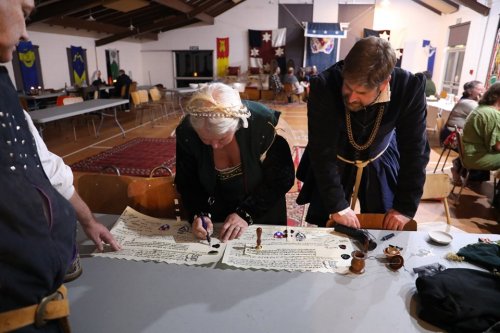
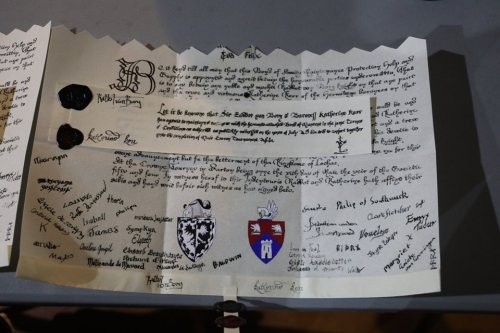
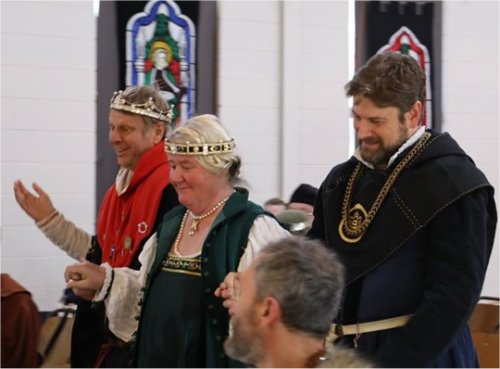
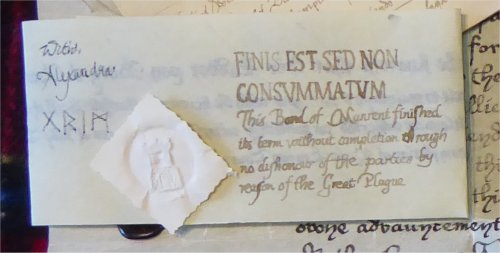
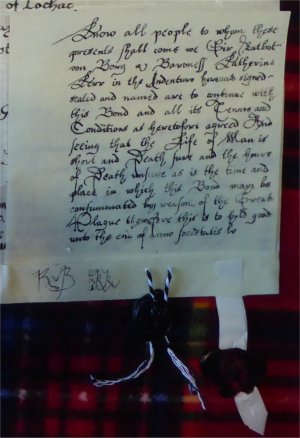
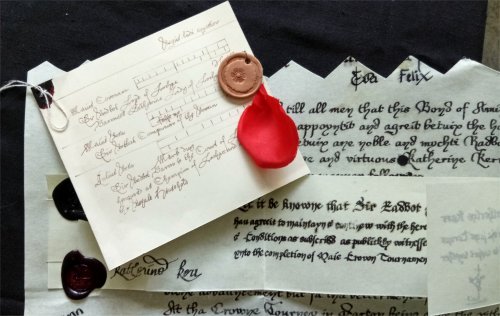
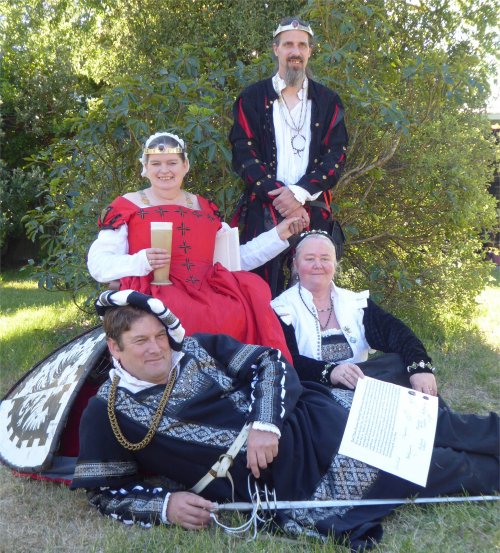
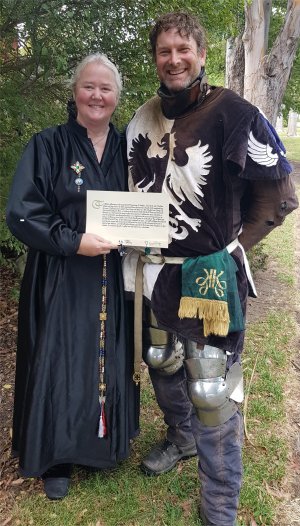
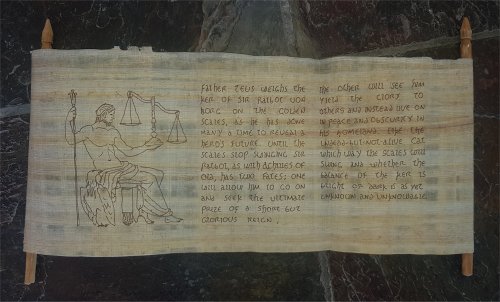
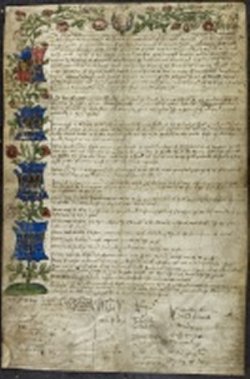
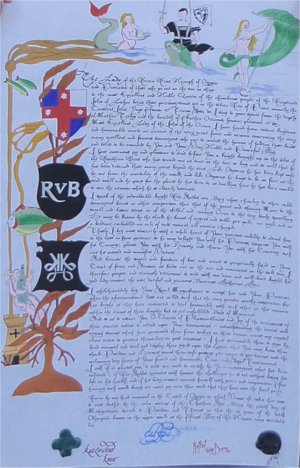
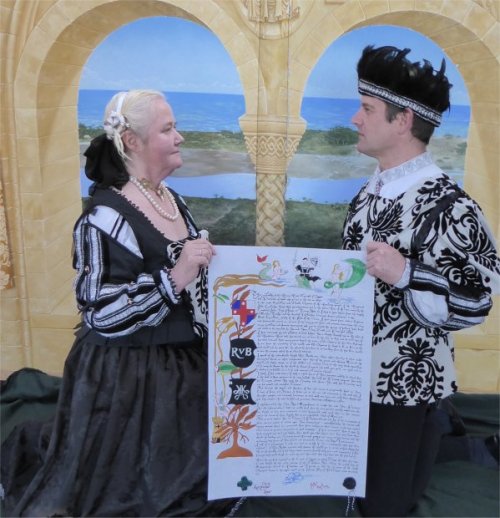


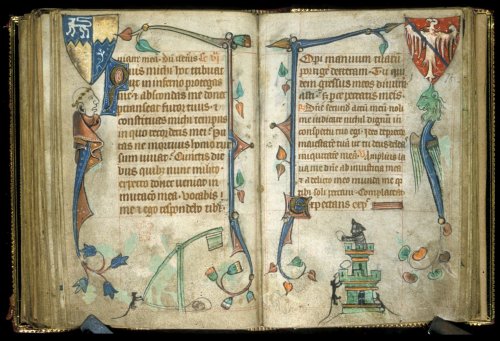
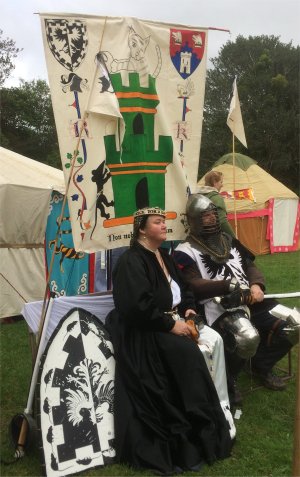
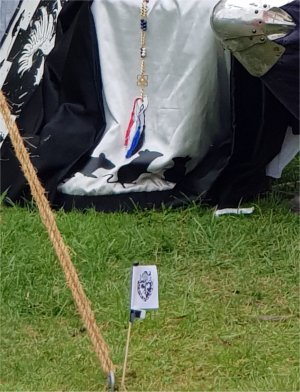
 Photo: Isabell Winter
Photo: Isabell Winter
